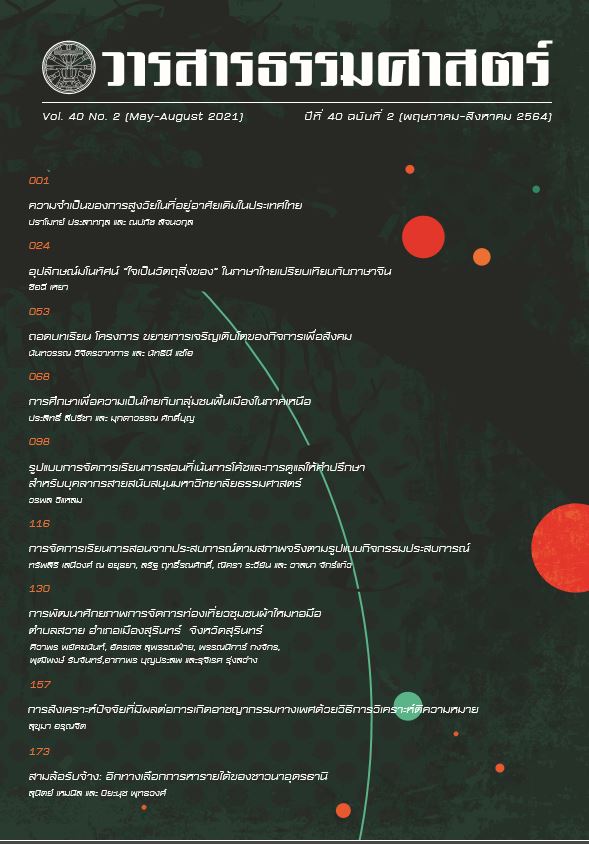The Potential Development of Hand-Woven Silk Community Tourism Management in Sawai Subdistrict, Mueang-Surin District, Surin Province
Main Article Content
Abstract
The objectives of this mixed-method research were: 1) to study the potential and success of handwoven silk community tourism management 2) to study the relationship and influence between the community management potential and the success of hand-woven silk community tourism management and 3) to study guidelines for the potential development of hand-woven silk community tourism management. in Sawai subdistrict, Mueang-Surin district, Surin province; Data were collected from people involved in handwoven silk community tourism management through questionnaire, interviewing form, and focused-group discussion.
The results found that the potential of a community tourism management and the tourism management potential is at a high level in general. Creating awareness of the value of hand-woven silk, information management for tourist serving and personnel potential were a high degree of relationship with the success of community tourism management. In terms of tourism attraction was a moderate correlation and found that the potential of hand-woven silk community tourism management and creating awareness of the value of hand-woven silk affecting the success of tourism management for the hand-woven silk community, Sawai Subdistrict, Mueang Surin District Surin.
According to guidelines for the potential development of hand-woven silk community tourism management at Sawai subdistrict, it is recommended to focus on the organization of tourism that demonstrates the uniqueness of the area. In addition, several tourism personnel should be increased and trained to have skills to pass on knowledge and values about silk weaving activities. This is aimed to promote and market the tourism through various public relation channels and encouraged communities to participate in a conservation of weavers' way of life and the wisdom of hand-woven silk.
Article Details
References
Best, J. W. (1978). Research in Education. Englewood Cliffs. New Jersy: Prentice Hall.
กรมพัฒนาชุมชน. (2562). ฐานข้อมูลหนึ่งตำบลหนึ่งผลิตภัณฑ์. สำนักส่งเสริมภูมิปัญญาท้องถิ่น และวิสาหกิจชุมชน. กระทรวงมหาดไทย. น. 7.
จิราพร คงรอด (2563). ความต้องการของนักท่องเที่ยวที่มีต่อการท่องเที่ยวเชิงสร้างสรรค์ในพื้นที่ชุมชนลุ่มน้ำคลองป่าพะยอม – คลองท่าแนะ จังหวัดพัทลุง. วารสารปาริชาต, 33(2), 100-116.
ชุมพล พืชพันธ์ไพศา และประพันธ์ แสงทองดี. (2561). ความพร้อมของแหล่งเรียนรู้ทางวัฒนธรรม ชุมชนโดยองค์กรปกครองส่วนท้องถิ่นต่อการพัฒนาไปสู่การจัดการการท่องเที่ยวเชิง สร้างสรรค์ในกลุ่มจังหวัดภาคกลางตอนบน พระนครศรีอยุธยา และอ่างทอง. วารสาร มจร สังคมศาสตร์ปริทรรศน์, 7(4), 242-251.
ณัฏฐพัชร มณีโรจน์. (2560). การจัดการท่องเที่ยวโดยชุมชน. วารสารวิชาการการท่องเที่ยวไทย นานาชาติ, 13(2), 25-46.
ณัฏฐ์ชรัชช์ สาระหงส์. (2562). สามประสานการท่องเที่ยวทางวัฒนธรรมโดยชุมชนปกาเกอญอ จังหวัดแม่ฮ่องสอน. กระแสวัฒนธรรม, 20(38), 3-16.
ตวงทอง สรประเสริฐ. (2563). แนวทางการพัฒนาสู่การเป็นพื้นที่ท่องเที่ยวเชิงประวัติศาสตร์ของ อำเภอพนัสนิคม จังหวัดชลบุรี. วารสารกระแสวัฒนธรรม, 21(40), 100-113.
บุญชม ศรีสะอาด. (2553). การวิจัยเบื้องต้น (พิมพ์ครั้งที่ 8). กรุงเทพฯ: สุวีริยสาสน์.
พัชรินทร์ จึงประวัติ. (2560). ความต้องการของชุมชนในการพัฒนาศักยภาพเพื่อการจัดการท่องเที่ยวเชิงอนุรักษ์: กรณีศึกษาตลาดคลองสวนร้อยปี อำเภอบางบ่อ จังหวัดสมุทรปราการ. วารสารการบริการและการท่องเที่ยวไทย, 12, 42-43.
พิมพ์ระวี โรจน์รุ่งสัตย์ (2563). การพัฒนาศักยภาพการท่องเที่ยวชุมชน: กรณีศึกษาชุมชนหนอง จอกจังหวัดเพชรบุรี. วารสารมนุษยสังคมปริทัศน์ คณะมนุษยศาสตร์และสังคมศาสตร์ มหาวิทยาลัยราชภัฏเพชรบุรี, 22(1), 21-38.
ยุทธ์ ไกยวรรณ์. (2551). การเลือกใช้สถิติที่เหมาะสม (พิมพ์ครั้งที่ 1). กรุงเทพฯ: ศูนย์สื่อเสริม กรุงเทพ.
ระพีพรรณ ทองห่อ และคณะ. (2549). แนวทางการพัฒนาการท่องเที่ยวภายใต้ศักยภาพ และ ข้อจำกัดของกลุ่มจังหวัดภาคกลางตอนบน. กรุงเทพฯ: สำนักงานคณะกรรมการ อุดมศึกษา.
วรวุฒิ ภักดีบุรุษ. (2563). การพัฒนาศักยภาพการท่องเที่ยวเชิงเกษตรโดยชุมชนของบ้านดอนซาก ตำบลห้วยงู อำเภอ หันคา จังหวัดชัยนาท โดยกระบวนการมีส่วนร่วม และการสื่อสารชุมชน. วารสารธรรมศาสตร์. 39(2), 24-45.
วิภา ศรีระทุ. (2551). ศักยภาพแหล่งท่องเที่ยวเชิงนิเวศในอำเภอเขาค้อ จังหวัดเพชรบูรณ์. (สารนิพนธ์ วท.ม.) สาขาวิชาการวางแผนและการจัดการการท่องเที่ยวเพื่ออนุรักษ์ สิ่งแวดล้อมบัณฑิตวิทยาลัย มหาวิทยาลัยศรีนครินทรวิโรฒ.
แสงเดือน รตินธร. (2555). ปัจจัยผลักดันและปัจจัยดึงดูดที่มีผลต่อนักท่องเที่ยวชาวจีนในการตัดสินใจมาท่องเที่ยวในประเทศไทย. วารสารวิชาการสมาคมสถาบันอุดมศึกษาเอกชนแห่งประเทศไทย, 18, 84-104.
อัครเดช สุพรรณฝ่าย. พรรณนิการ์ กงจักร และศิวาพร พยัคฆนันท์. (2562). กลยุทธ์การจัดการเศรษฐกิจชุมชนเพื่อยกระดับคุณภาพชีวิตช่างทอผ้าไหม ตำบลสวาย อำเภอเมืองสุรินทร์ จังหวัดสุรินทร์. รายงานการวิจัยฉบับสมบูรณ์. มหาวิทยาลัยราชภัฏสุรินทร์.
อัจฉราพรรณ ตั้งจาตุรโสภณ. บุษยา วงษ์ชวลิตกุล และธนวรรณ แสงสุวรรณ. (2563). โมเดล สมการโครงสร้างความจงรักภักดีของนักท่องเที่ยวชาวไทยที่มีต่อจุดหมายปลายทาง ในการท่องเที่ยวภาคตะวันออกเฉียงเหนือ ประเทศไทย. วารสารชุมชนวิจัย มหาวิทยาลัย ราชภัฏนครราชสีมา, 14(2), 174-188.
องค์การบริหารส่วนตำบลสวาย. (2562). ผลการดำเนินงานประจำปีงบประมาณ 2562. รายงานประจำปี. องค์การบริหารส่วนตำบลสวาย.

